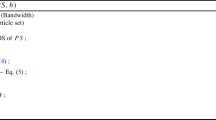Abstract
The purpose of this paper is to revisit the Multiobjective Population-Based Incremental Learning method and show how its performance can be improved in the context of a real-world financial optimization problem . The proposed enhancements lead to both better performance and improvements in the quality of solutions, which can represent millions of dollars for the insurance company in terms of recoveries. Its performance was assessed in terms of runtime and speedup when parallelized. Also, metrics such as the average number of solutions, the average hypervolume, and coverage have been used in order to compare the Pareto frontiers obtained by both the original and enhanced methods. Results indicated that the proposed method is 22.1% faster, present more solutions in the average (better defining the Pareto frontier) and often generates solutions having larger hypervolumes. The method achieves a speedup of 15.7 on 16 cores of a dual socket Intel multi-core machine when solving a Reinsurance Contract Optimization problem involving 15 layers or sub-contracts .













Similar content being viewed by others
Notes
Actually, premiums are stated by unit of limit, also know as a Rate on Line.
References
Alba E (2002) Parallel evolutionary algorithms can achieve super-linear performance. Inf Process Lett 82(1):7–13
Baluja S (1994) Population-based incremental learning: a method for integrating genetic search based function optimization and competitive learning. Tech Rep, Pittsburgh
Benfield AON (2014) Annual global climate and catastrophe report, impact forecasting. http://thoughtleadership.aonbenfield.com/Documents/20140113. Accessed 13 Apr 2014
Brown L, Beria AA, Cortes O, Rau-Chaplin A, Wilson D, Burke N, Gaiser-Porter J (2014) Parallel MO-PBIL: computing pareto optimal frontiers efficiently with applications in reinsurance analytics. In: Conference on high performance computing simulation (HPCS), 2014 International, pp 766–775
Bureerat S (2011) Improved population-based incremental learning in continuous spaces. Soft Comput Ind Appl 96:77–86
Coelho M, Rau-Chaplin A (2014) eXsight: an analytical framework for quantifying financial loss in the aftermath of catastrophic events. In: Proceedings of the workshop ISSASiM (DEXA 2014)
Cortes O, Rau-Chaplin A, Wilson D, Gaiser-Porter J (2014) On PBIL, DE and PSO for optimization of reinsurance contracts. In: Esparcia-Alczar AI, Mora AM (eds) Applications of evolutionary computation, lecture notes in computer science. Springer, Berlin, pp 227–238
Cortes OAC, Rau-Chaplin A, Wilson D, Cook I, Gaiser-Porter J (2013) Efficient optimization of reinsurance contracts using discretized PBIL. In: The third international conference on data analytics, pp 18–24
Kennedy J, Eberhart R (1995) Particle swarm optimization. In: IEEE international conference on neural networks, vol 4. IEEE, pp 1942–1948
Michalewicz Z (1999) Genetic algorithms + Data structure = Evolution programs, 3 edn
Mistry S, Gaiser-Porter J, McSharry P, Armour T (2013) Parallel computation of reinsurance models (Unpublished)
Mitschele A, Oesterreicher I, Schlottmann F, Seese D (2015) Heuristic optimization of reinsurance programs and implications for reinsurance buyers. In: Operations research proceedings, pp 287–292
Montgomery D, Runger GC (2010) Applied statistics and probability forengineers. Wiley, Hoboken
Oesterreicher I, Mitschele A, Schlottmann F, Seese D (2006) Comparison of multi-objective evolutionary algorithms in optimizing combinations of reinsurance contracts. In: Proceedings of the 8th annual conference on genetic and evolutionary computation, GECCO ’06ACM, New York, NY, pp 747–748
Salcedo-Sanz S, Carro-Calvo L, Claramunt M, Castaer A, Mrmol M (2014) Effectively tackling reinsurance problems by using evolutionary and swarm intelligence algorithms. Risks 2(2):132
Servais M, de Jager G, Greene JR (1997) Function optimisation using multiple-base population based incremental learning. In: The eighth annual South African workshop on pattern recognition, Rhodes University
Storn R, Price K (1995) Differential evolution: a simple and efficient adaptive scheme for global optimization over continuous spaces. ftp://ftp.icsi.berkeley.edu/pub/techreports/1995/tr-95-012.pdf
Tierney L, Rossini AJ, Li N, Sevcikova H Snow package. https://cran.r-project.org/web/packages/snow/
Wang H, Cortes O, Rau-Chaplin A (2015) Dynamic optimization of multi-layered reinsurance treaties. In: The 30th ACM/SIGAPP symposium on applied computing
Yao X, Liu Y, Lin G (1999) Evolutionary programming made faster. IEEE Trans Evolut Comput 3(2):82–102
Yuan B, Gallagher M (2003) Playing in continuous spaces: some analysis and extension of population-based incremental learning. In: IEEE Congress on evolutionary computation. IEEE, pp 443–450
Zhang QH (2007) MOEA/D: a multiobjective evolutionary algorithm based on decomposition. IEEE Trans Evolut Comput 11(6):712–731
Acknowledgements
The authors would like to thank CNPq (Conselho Nacional de Desenvolvimento Científico e Tecnológico) and IFMA (Instituto Federal de Educação, Ciência e Tecnologia do Maranhão) for funding this research. We also would like to thank Willies group for providing the anonymous data.
Author information
Authors and Affiliations
Corresponding author
Rights and permissions
About this article
Cite this article
Carmona Cortes, O.A., Rau-Chaplin, A. Enhanced multiobjective population-based incremental learning with applications in risk treaty optimization . Evol. Intel. 9, 153–165 (2016). https://doi.org/10.1007/s12065-016-0147-0
Received:
Revised:
Accepted:
Published:
Issue Date:
DOI: https://doi.org/10.1007/s12065-016-0147-0




